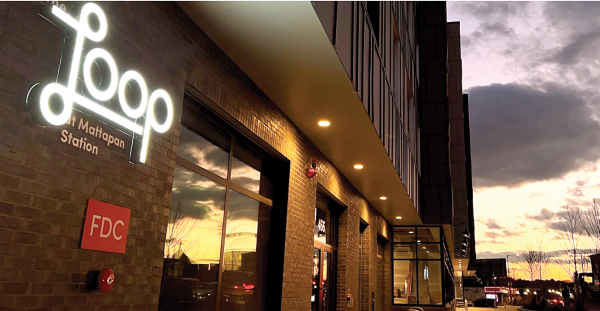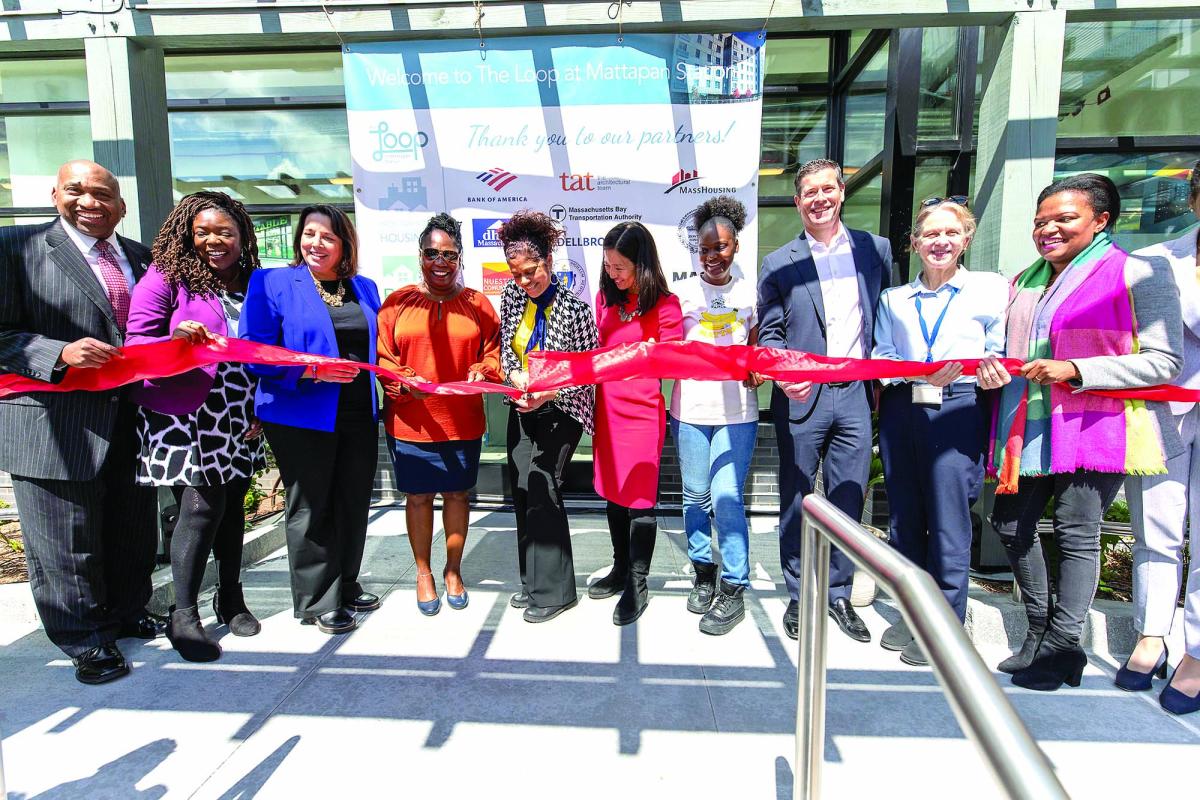May 10, 2023

The Loop, next to the terminus of the MBTA trolley line in Mattapan Square, brings 135 affordable housing units as part of a transit-oriented development that took years to build.
Brothers Deli is an essential part of Mattapan Square, opening at 7:30 a.m. seven days a week to serve up hearty breakfasts, scrambled eggs and grits, and other fare for the steady stream of people coming in off Blue Hill Avenue. Nine years ago, it was also the site of a fateful meeting between three state lawmakers who had just toured a MBTA-owned vacant lot on River Street, a four-minute walk away, across from the terminus of the Mattapan trolley line.
Considered one of the last buildable spots in the area, the 2.57-acre lot, primarily used for parking, had been the subject of multiple requests for proposals (RFPs) in the years before then. Each effort fell short. In 2007, a recession led to the collapse of a community development corporation’s proposal, while in 2012, no proposals came in.
As the three lawmakers — state Sen. Linda Dorcena Forry and state Reps. Russell Holmes and Dan Cullinane – sat down inside the eatery, the MBTA had once again put out an RFP, which generated just one response, a $1.5 million offer from Boston Preparatory Charter School, which was based in Hyde Park and had been renting space inside an old Catholic school.
They agreed on a united front: The process did not have enough community involvement, and given its location, the site should become home to housing, as the city faced a housing crisis back then that persists today.
“We thought transit-oriented development was the right answer from the beginning,” Holmes said. “So, we said, ‘let’s push back.’”
Added Cullinane, who now works as a lobbyist for the law firm Kearney, Donovan & McGee: “As a delegation we did everything with a team approach. Everyone was on the same page, in the same boat, rowing in the same direction.”
Community leaders agreed with them.
Said Marydith Tuitt, a community leader and commander of the Carter American Legion Post 16: “The community really didn’t want the school. Our younger people were trying to keep in the community, and stay where they grew up, as adults. We were having a struggle of space, having accessible apartments.”
Dorcena Forry called Beverly Scott, who then was the general manager of the MBTA, and laid out the delegation’s thinking. “The charter school would’ve been great, but it’s not paying into the tax base,” said Forry, who is married to Reporter publisher Bill Forry and now serves as the newspaper’s associate publisher.
The lawmakers helped Boston Preparatory find another location, on River Street near the Mattapan-Hyde Park line. (The school, with students in grades 6 through 12, finished construction of its building in 2018.)
In 2015, the MBTA put the lot back on the market and eventually received two bids, with The Preservation of Affordable Housing (POAH) Inc., supported by Roxbury-based Nuestra Comunidad Development Corp., winning out over Trinity Financial, which had developed the Carruth Building next to the Ashmont MBTA station.

Pictured at the Loop’s dedication on April 25: (l-r) Rep. Russell Holmes, Councillor Ruthzee Louijeune, Lt. Gov. Kim Driscoll, Chrystal Kornegay, MassHousing executive director, Loop resident Janet Getchell, Mayor Wu, a young Loop resident, Bank of America’s Miceal Chamberlain, Sheila Dillon, director of Housing for the city of Boston, former Sen. Linda Dorcena Forry.
Photo courtesy Mayor’s office
On a sunny Tuesday last month, city and state officials joined developers and financiers of the project to cut the ribbon on a new 6-story building with 6 studio apartments, 38 one-bedroom apartments, 81 two-bedroom apartments, 10 three-bedroom apartments, and a nonprofit grocery store chain, The Daily Table, doing business in the commercial space. The facility also features a roof deck, a gym, an E-bike station, and top-to-bottom wifi/broadband access.
According to state officials, there were 3,000 applicants for the 135 rental units, almost half of which are designated for families making $70,100 or less a year.
Aaron Gornstein, POAH’s president and CEO, said the building, named “The Loop,” was the “epitome” of a transit-oriented development constructed to energy-efficient standards.
As he and others spoke at the ribbon-cutting, trolleys regularly ding-dinged in the background, making their way through the station’s loop, the apparent namesake of the building. “I don’t think you can get any closer to public transit than this property,” he said.
The building opened as city officials are looking to create greater density in Mattapan Square, with taller buildings, and a center bus lane up Blue Hill Avenue, to keep the economic development of one of the city’s key gateways ongoing.
Holmes reflected on the long road to get there when he got up to the microphone, and days later in an interview with the Reporter, and said, “It’s all of the things that Dan, myself, and Linda were hoping for.”
“Not that a school is not important,” he said, “but 135 members of the community having a place to live, right next to a train station, I think was the right answer.”


